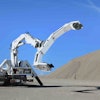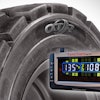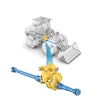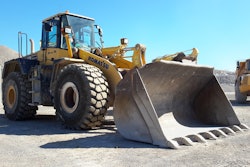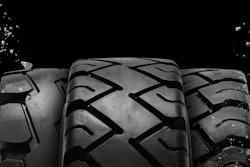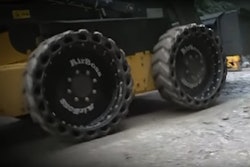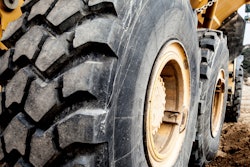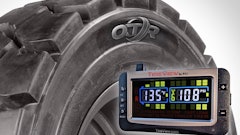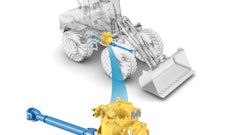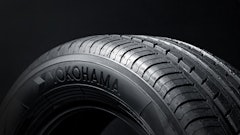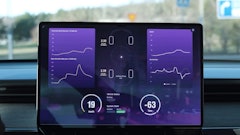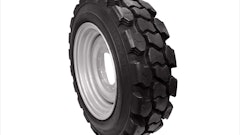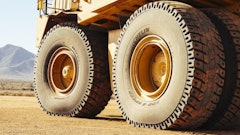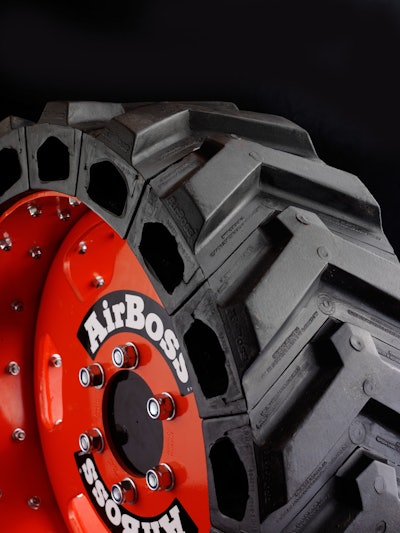
“Vehicle downtime due to tire damage is a big drain on operating costs, especially in hard to reach remote locations where the wait for specialist assistance can be many hours,” says Don Gillanders, CEO of airBOSS Ltd. To help customers overcome this challenge, the company developed the airBOSS segmented tire system.
The wheel is composed of a metal rim onto which individual rubber segments are bolted—hence the name BOSS (bolt on segmented system). When a segment is damaged, it can quickly be replaced with a new one. 
“airBOSS was originally developed in North America to cope with the demands that rugged operating environments make on wheeled vehicles which ordinarily defeat traditional pneumatic tires,” says Gillanders. And while he notes foam filled, solid or semi-solid tires are more durable than pneumatics, when damage occurs the entire wheel needs to be replaced, which is costly.
Individually replacing damaged segments on the airBOSS tire, however, minimizes these repair costs since the small segment is going to be cheaper than a whole new tire. “Our field trials on working demolition/construction sites have indicated that annual savings of around $27,000 per vehicle can be achieved through [the use of] airBOSS when all associated expense of downtime, call out charges and replacement tires are taken into account,” says Gillanders.
Additionally, the ease with which the segment can be replaced by the vehicle operator further reduces downtime. Gillanders says any individual damaged section can be replaced within minutes using a simple torque wrench, without jacking the vehicle. Spare replacement segments can be kept directly in the vehicle, eliminating the need to waste time finding or waiting for a spare. This is particularly beneficial for increasing the safety of operators working in remote situations who might otherwise be a long distance from the nearest maintenance facility. Vehicles fitted with airBOSS wheels can still operate with several damaged segments if necessary, as well.
What makes airBOSS different?
The airBOSS system is composed of 18, 20 or 22 individual segments in standard wheel sizes bolted onto a rim tailored to an individual vehicle. Gillanders says each vehicle make and model requires a specific wheel rim configuration due to the necessary number of stud holes, PCD, center bore and even paint finish, and the company holds blank rims that are then machined according to each customer requirement; airBOSS has over 600 patterns for varying equipment types.
The rubber segments, on the other hand, are standard for any vehicle. “We currently carry seven standard sizes but have the capability to make three further segment sizes on our machinery if required,” Gillanders notes.
He notes the company has spent several years improving upon the original concept, leading to the redesign of several key aspects of the system. One of these includes the use of a hollow chamber across the width of the rim, allowing the tire to flex more easily than a solid or foam filled tire for a more comfortable ride. It also means less rubber compound is used, reducing the weight on each vehicle axle.
Another development was the creation of a more durable compound formula for the tire segments. In addition, airBOSS encapsulated the plate inside each individual segment, creating a 1.4 in. (35.56 mm) thick protective barrier. “This means that not only are the segments more capable of withstanding the operating forces over uneven terrain, the compound itself can take much more punishment than its foam or air filled competitors,” says Gillanders.
While damage comparisons with other tire types vary according to operating conditions, he says the company’s field trials have shown that for every nine replacement pneumatic tires, only 23 airBOSS segments required replacing. The company has even seen segments which last 10 years on some farm machinery, further emphasizing the impact individual operating conditions can have on a tire design.
Changing the segment shape to that of a chevron design was yet another improvement made over the years. This shape works together with the rim’s hollow chamber to provide a flatter profile than a traditional tire, which is naturally concave. The flatter profile means more of the tire surface comes into contact with the ground, and spreads vehicle weight more evenly over its four corners. The chevron pattern also enables the individual segments to interlock with one another, enhancing the stability of each segment around the rim. “In turn, this gives the driver a more comfortable ride and the vehicle better traction,” says Gillanders. “Operators of diggers fitted with airBOSS will also notice an improvement in digging efficiency as a result.” 
The airBOSS tire system is primarily designed for use on slower moving compact construction equipment such as skidsteers, backhoes and dumpers. Although it is classified as permissible for use on public highways, Gillanders says the system’s maximum rolling velocity is around 20 mph. This means it is not usually fitted onto four-wheel drive vehicles or those with independent axles. He notes, however, the company has developed a larger version for the double wheeled excavator market and is currently in the R&D stages for this technology.
airBOSS is approved by all major OEMs as an option on their equipment—such as Bobcat, New Holland, Caterpillar and JCB—and can be installed directly onto new machines as an optional replacement to the original wheels. It is also available as a retrofit option for machine owners.
“In today’s economic climate, efficiency and cost savings are paramount, as are health and safety concerns,” says Gillanders. “We have proved that fitting airBOSS to construction equipment can contribute to all of these things.
“We believe airBOSS is the only true solution to the elimination of downtime due to flat or damaged tires and is affordable to all – from individual owner operators through to major fleet owners,” he concludes.

